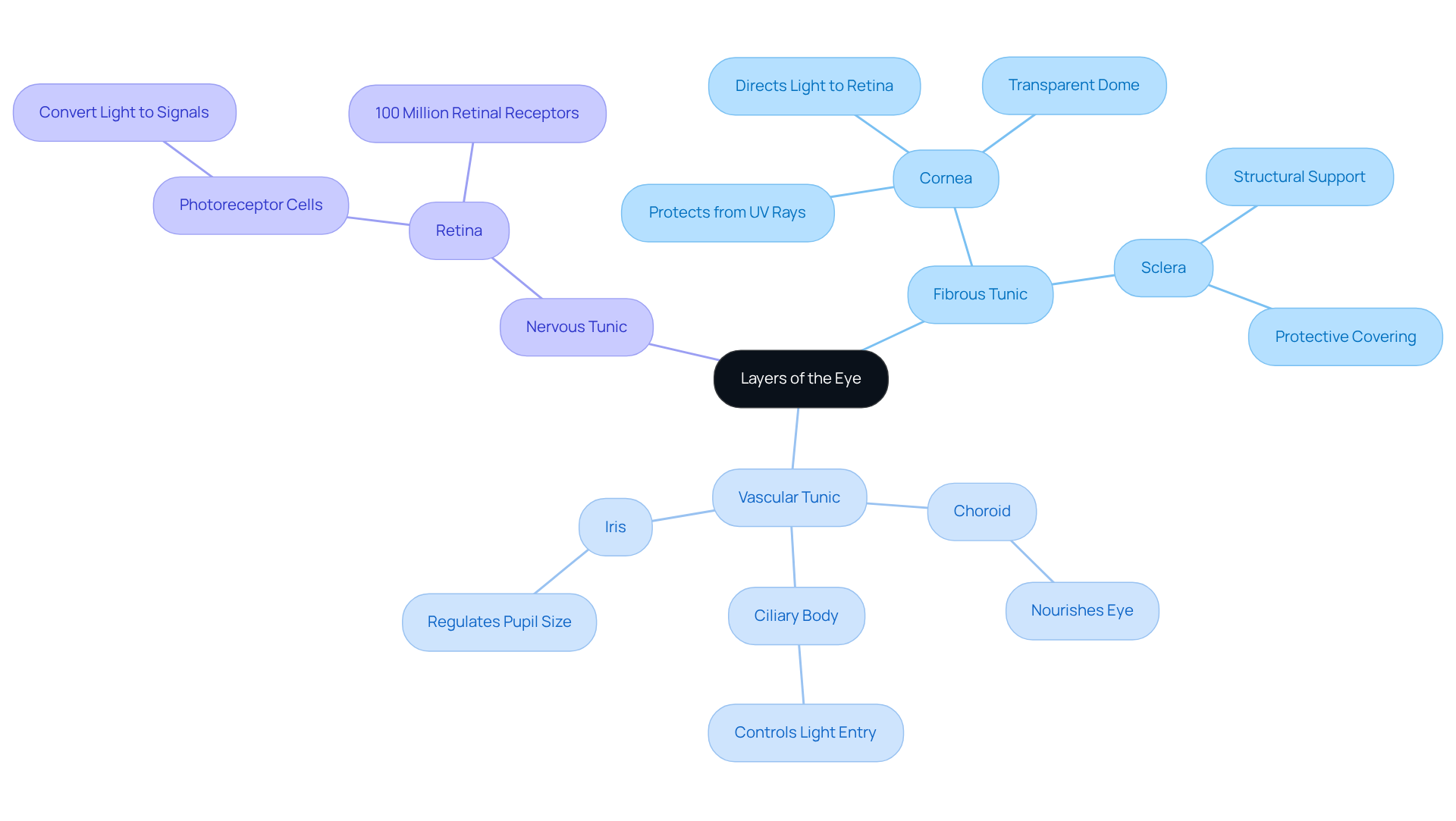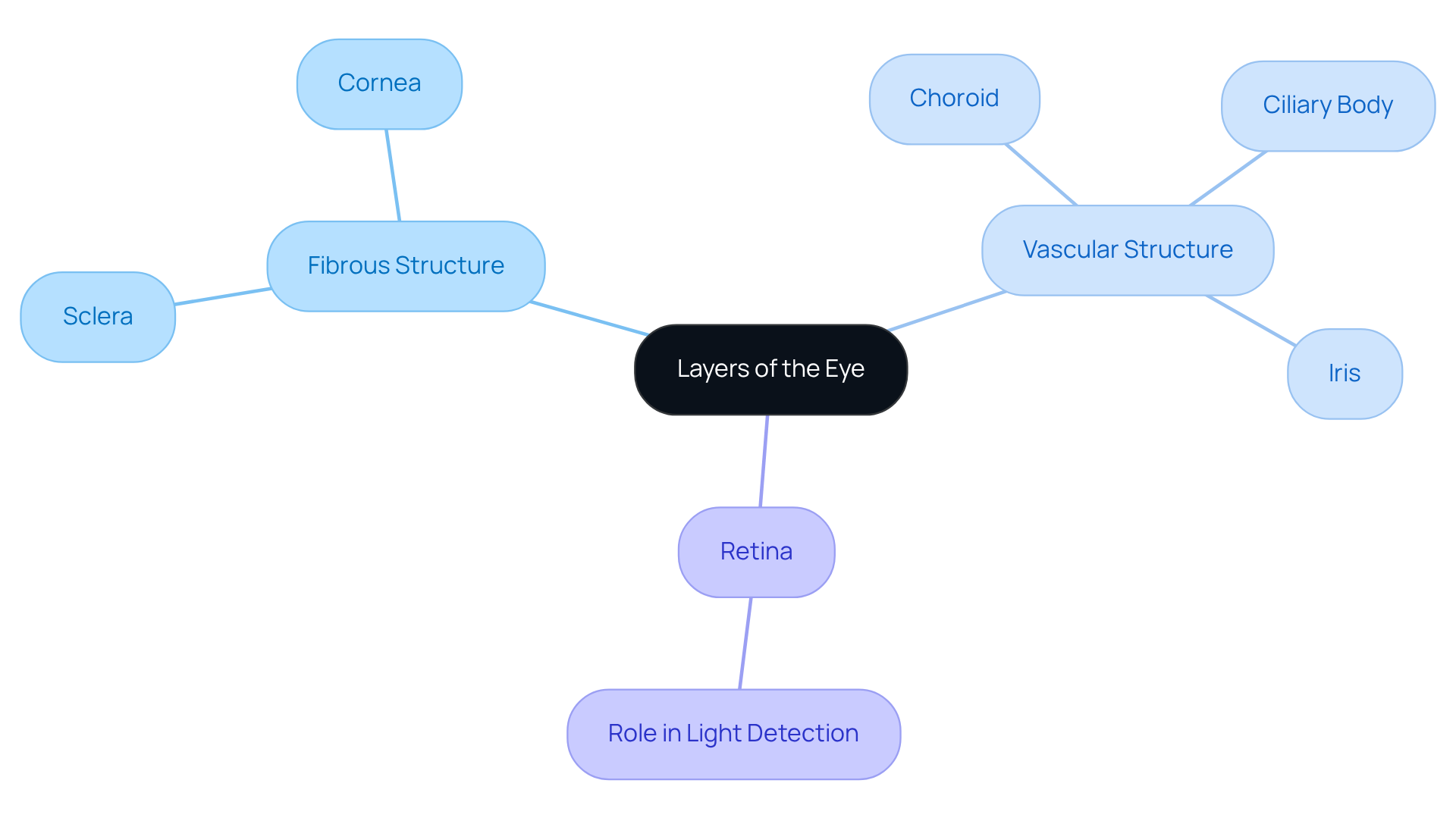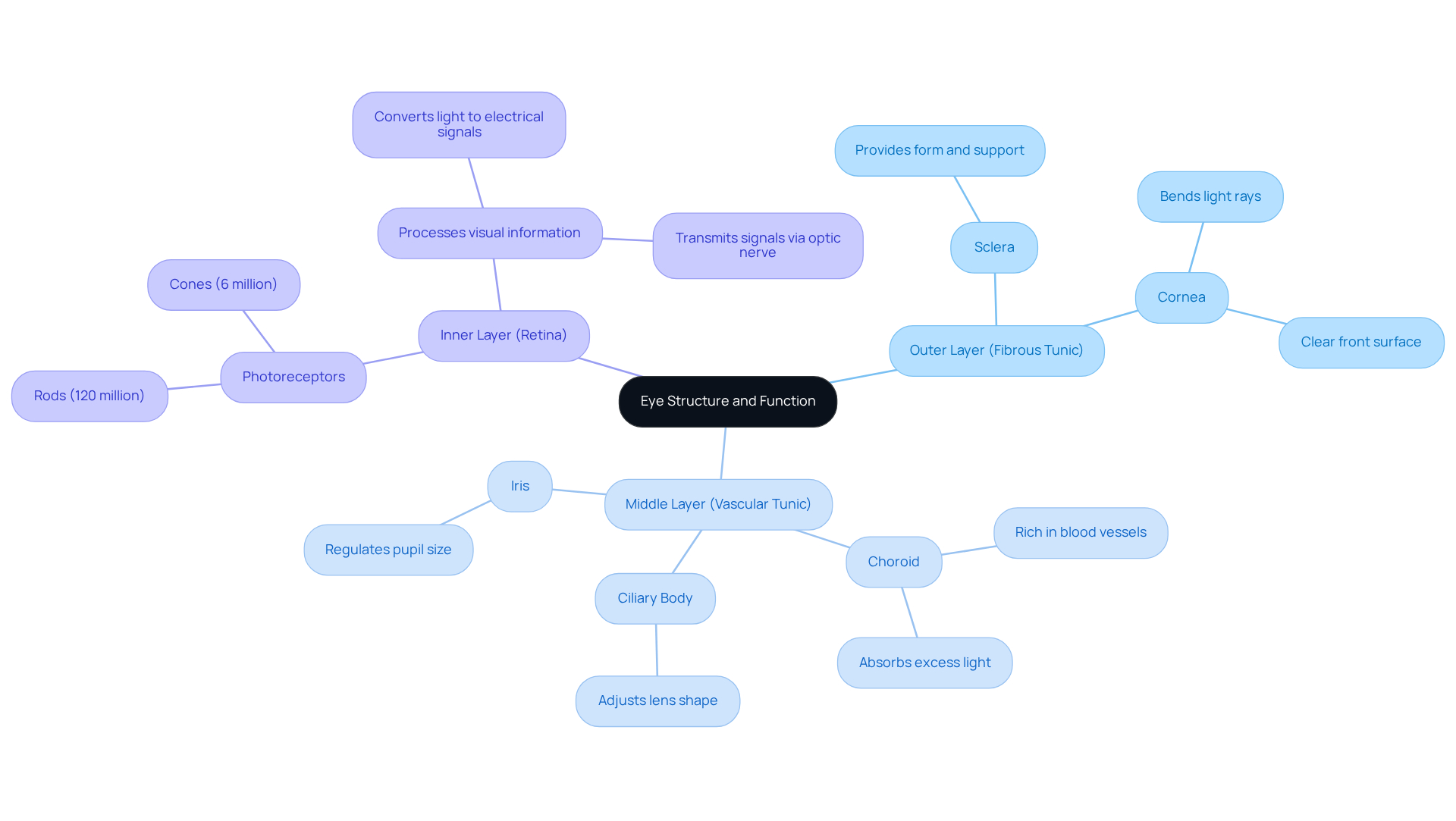Posted by: Northwest Eye in General on July 11, 2025
Overview
This article aims to help you understand the layers of the eye, which include the fibrous tunic, vascular tunic, and nervous tunic. Each of these layers plays a crucial role in your vision. We understand that eye health is a concern for many, and it’s important to know how these layers work together to protect your eye, regulate light, and convert visual information into neural signals.
Maintaining eye health is essential to prevent conditions like cataracts and glaucoma, which can impair your sight. We want to reassure you that taking care of your eyes can make a significant difference. Remember, you are not alone in this journey; many share your concerns, and seeking regular eye care is a proactive step towards safeguarding your vision.
Introduction
Understanding the intricate layers of the eye is essential for appreciating how vision works. Each layer—the fibrous tunic, vascular tunic, and nervous tunic—plays a distinct and crucial role in maintaining eye health and ensuring clear sight.
We understand that many individuals remain unaware of how these layers interact and the impact that common conditions can have on visual perception. It’s common to feel uncertain about what happens when one of these layers falters.
Awareness and proactive care can make a significant difference in preserving sight, and we are here to help you through this process.
Define the Layers of the Eye
Be Eye Wise and understand what the cornea is. We know that understanding the layers of the eye can feel overwhelming, but we’re here to help you through this process. The human eye consists of three main sections, which can also be described as layers of the eye:
- The outer section known as the fibrous tunic
- The middle section referred to as the vascular tunic
- The inner section called the nervous tunic
The outer covering consists of the sclera and cornea, which function to offer structural support and safeguard against external elements. The cornea, a transparent dome-shaped structure at the very front of the eye, covers the pupil and the colored iris. It plays an essential role in directing brightness onto the retina, ensuring sharp sight. Additionally, the cornea helps protect the eye from harmful UV rays and contributes to overall eye health by maintaining a balance of fluid.
We understand that you may have . The central section comprises the choroid, ciliary body, and iris, serving an essential function in nourishing the eye and controlling the quantity of illumination that enters. Ultimately, the inner stratum, or retina, is abundant in photoreceptor cells that convert light into neural signals, a process crucial for sight.
Research indicates that the fibrous tunic not only protects the eye but also maintains its shape. This underscores its significance in overall ocular health. Comprehending the complex arrangement of the layers of the eye, particularly the roles of the cornea, is essential for recognizing how these components collaborate to enable sight. Remember, you are not alone in this journey; we are here to support you every step of the way.

Explain the Importance of Eye Layers in Vision
The eye is made up of several unique layers, each playing a vital role in the mechanism of sight. We understand that the complexity of the eye can be overwhelming, but knowing its components can help ease your concerns. The fibrous structure, which includes the sclera and cornea, acts as a protective barrier while helping to maintain the eye’s shape.
At the same time, the vascular structure—comprising the choroid, ciliary body, and iris—supplies blood and essential nutrients to the layers of the eye, ensuring their proper function. At the deepest level, the layers of the eye, including the retina, are crucial for detecting illumination and starting the visual process, transforming light into neural signals that the brain perceives as images.
It’s common to feel anxious about vision issues, and dysfunction in any of these levels can lead to significant problems, such as blurred sight, distortion, or even blindness. For instance, conditions like cataracts, which affect approximately 17.2% of Americans over 40, can cloud the lens and impact light transmission. Retinal diseases can also impair the retina’s ability to process visual information. Thus, preserving the health of these structures is essential for optimal vision.
We encourage you to prioritize your through regular check-ups and timely intervention for any developing problems. These proactive measures are crucial for maintaining sight and avoiding lasting harm. At Northwest Eye, we emphasize the importance of proactive care, offering innovative treatments like the Light Adjustable Lens. We also provide educational resources, such as the Eye Condition Library, to support you in understanding and managing your eye health.
Research continues to highlight the significance of eye tissue health, revealing that proactive care can reduce the risks associated with age-related changes and other ocular conditions. Remember, we are here to help you through this process, ensuring you receive the care and support you need.

Detail the Structure and Function of Each Eye Layer
The structure of the eye is thoughtfully arranged into three distinct layers, each playing a vital role in vision. The outer covering, known as the fibrous tunic, comprises the sclera and the cornea. The sclera, the eye’s white part, provides form and support, while the cornea serves as the clear front surface that bends light rays, allowing them to enter the eye. This layer is essential for maintaining the eye’s integrity and effectively directing light.
The middle layer, or vascular tunic, includes the choroid, ciliary body, and iris. The choroid is rich in blood vessels, delivering crucial nutrients to the eye and helping to absorb excess light to prevent scattering. The ciliary body adjusts the shape of the lens for focusing on objects at various distances, while the iris controls the amount of light entering the eye by regulating the size of the pupil, much like a camera aperture.
The inner layer, or retina, contains photoreceptors—approximately 120 million rods and 6 million cones—that detect light and color. These cells convert light into electrical signals, which are sent to the brain through the optic nerve, enabling the perception of images. The retina’s structure is vital for clear vision, as it processes visual information and transmits it to the brain for interpretation.
Understanding the intricate roles of the layers of the eye is important for addressing common eye issues, such as , which can cloud the lens and affect clarity of vision. Symptoms like blurred vision may indicate the presence of cataracts or other eye conditions. At Northwest Eye, we provide innovative solutions like the Light Adjustable Lens (LAL), allowing for personalized adjustments after surgery, enhancing the possibility of living without glasses. The interplay among the layers of the eye emphasizes the complexity of the eye and underscores the importance of comprehensive eye care in maintaining optimal eye health.

Illustrate Common Conditions Affecting Eye Layers
Common conditions that influence sight include cataracts, glaucoma, and retinal detachment, which all affect the layers of the eye significantly. We understand that facing these conditions can be daunting.
Cataracts arise when the lens becomes opaque, resulting in hazy sight and challenges with low-light visibility. Approximately 95% of cataracts are age-related, typically developing after the age of 40. At Northwest Eye, we believe that understanding your eye health is crucial. This is why we emphasize the Be Eye Wise initiative—better knowledge leads to and a better life.
Glaucoma, marked by harm to the optic nerve, frequently arises from elevated intraocular pressure. It can result in permanent loss of sight if not managed effectively. Research indicates that glaucoma can affect the optic nerve’s functionality, making early detection crucial for preserving sight. Our team at Northwest Eye is dedicated to educating patients about the importance of regular check-ups and monitoring. We understand how vital it is to stay informed about your eye health.
Retinal detachment is another serious condition where the retina separates from its underlying tissue, potentially resulting in permanent loss of sight. The incidence of retinal detachment following cataract surgery can reach 0.7% or higher, highlighting the importance of monitoring patients post-operatively. Other common issues include uveitis, an inflammation of the vascular layer of the eye, and dry eye syndrome, which affects the layers of the eye’s surface and can lead to discomfort and vision problems.
Understanding these conditions is vital for early detection and timely treatment, ensuring better outcomes for patients. Additionally, resources like the Eye Condition Library and symptom checkers at Northwest Eye empower you to understand your conditions better. Innovative treatment options, such as the Light Adjustable Lens and refractive lens exchange, are also available to enhance patient care. Regular eye care and check-ups are essential for maintaining eye health and preventing complications.
To learn more about your eye health and the services offered at Northwest Eye, or to schedule an appointment, please visit our website. Hear from our patients:
- “Great place. The doctors and staff were extremely patient with our very active 15 months old Daughter.” – Lydea L.
- “All of the staff at Northwest Eye are friendly and get your needs taken care of in the best of ways. A visit to any of the clinics is a great experience.” – Perry H.
We are here to help you through this process, and our dedicated team of doctors is ready to support you on your journey to better eye health.
Conclusion
Understanding the layers of the eye is essential for appreciating how vision works and for maintaining your eye health. The eye is a complex organ made up of three primary layers: the fibrous tunic, the vascular tunic, and the nervous tunic. Each layer has a unique role, from protecting the eye and directing light to processing visual information. By recognizing the importance of these layers, you not only enhance your knowledge about eye function but also highlight the need for proactive eye care.
The fibrous tunic, which includes the sclera and cornea, offers structural support and protection. In contrast, the vascular tunic nourishes the eye and regulates light entry. The inner nervous tunic, primarily the retina, is crucial for converting light into neural signals. Conditions such as cataracts, glaucoma, and retinal detachment underscore the significance of these layers, as any dysfunction can lead to serious vision problems. Regular check-ups and an awareness of your eye health can help mitigate risks associated with these conditions.
Ultimately, prioritizing your eye health through education and proactive measures is vital for preserving your vision and enhancing your quality of life. Understanding the layers of the eye and their functions empowers you to take charge of your eye health, ensuring that you remain informed and proactive in seeking care. We understand that staying vigilant can feel overwhelming, but by utilizing available resources, you can protect your vision and enjoy the world around you with clarity and confidence.
Frequently Asked Questions
What are the main layers of the eye?
The human eye consists of three main layers: the outer section known as the fibrous tunic, the middle section referred to as the vascular tunic, and the inner section called the nervous tunic.
What does the fibrous tunic include and what is its function?
The fibrous tunic includes the sclera and cornea, which provide structural support and protect the eye from external elements.
What is the role of the cornea in the eye?
The cornea is a transparent dome-shaped structure that covers the pupil and iris. It directs brightness onto the retina for sharp sight, protects the eye from harmful UV rays, and helps maintain fluid balance for overall eye health.
What components make up the vascular tunic?
The vascular tunic comprises the choroid, ciliary body, and iris, which nourish the eye and control the amount of light entering it.
What is the function of the nervous tunic?
The nervous tunic, primarily made up of the retina, contains photoreceptor cells that convert light into neural signals, which is essential for vision.
Why is understanding the layers of the eye important?
Understanding the layers of the eye, particularly the roles of the cornea, helps recognize how these components work together to enable sight and maintain ocular health.






